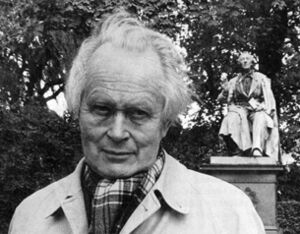Piet Hein (nonfiction)
Piet Hein (16 December 1905 – 17 April 1996) was a Danish mathematician, inventor, designer, author, and poet, often writing under the Old Norse pseudonym "Kumbel" meaning "tombstone". His short poems, known as gruks or grooks (Danish: gruk), first started to appear in the daily newspaper "Politiken" shortly after the Nazi occupation in April 1940 under the pseudonym "Kumbel Kumbell".
Hein, a direct descendant of Piet Pieterszoon Hein, the 17th century Dutch naval hero, was born in Copenhagen, Denmark. He studied at the Institute for Theoretical Physics of the University of Copenhagen (later to become the Niels Bohr Institute), and Technical University of Denmark. Yale awarded him an honorary doctorate in 1972. He died in his home on Funen, Denmark in 1996.
Piet Hein, who, in his own words, "played mental ping-pong" with Niels Bohr in the inter-War period, found himself confronted with a dilemma when the Germans occupied Denmark. He felt that he had three choices: Do nothing, flee to neutral Sweden or join the Danish resistance movement. As he explained in 1968, "Sweden was out because I am not Swedish, but Danish. I could not remain at home because, if I had, every knock at the door would have sent shivers up my spine. So, I joined the Resistance."
Taking as his first weapon the instrument with which he was most familiar, the pen, he wrote and had published his first "grook" (gruk in Danish). It passed the censors who did not grasp its real meaning.
CONSOLATION GROOK
Losing one glove is certainly painful, but nothing compared to the pain of losing one, throwing away the other, and finding the first one again.
The Danes, however, understood its importance and soon it was found as graffiti all around the country. The deeper meaning of the grook was that even if you lose your freedom ("losing one glove"), do not lose your patriotism and self-respect by collaborating with the Nazis ("throwing away the other"), because that sense of having betrayed your country will be more painful when freedom has been found again someday.
After Liberation, Scandinavian architects, tired of square buildings but cognizant that circular buildings were impractical, asked Piet Hein for a solution. Applying his mathematical prowess to the problem, Piet Hein proposed to use the superellipse which became the hallmark of modern Scandinavian architecture.
In addition to the thousands of grooks he wrote, Piet Hein devised the games of Hex, Tangloids, Tower, Polytaire, TacTix, Nimbi, Qrazy Qube, Pyramystery, and the Soma cube. He advocated the use of the superellipse curve in city planning, furniture making and other realms. He also invented a perpetual calendar called the Astro Calendar and marketed housewares based on the superellipse and superegg.
In the News
Fiction cross-reference
Nonfiction cross-reference
External links
- Piet Hein @ Wikipedia
